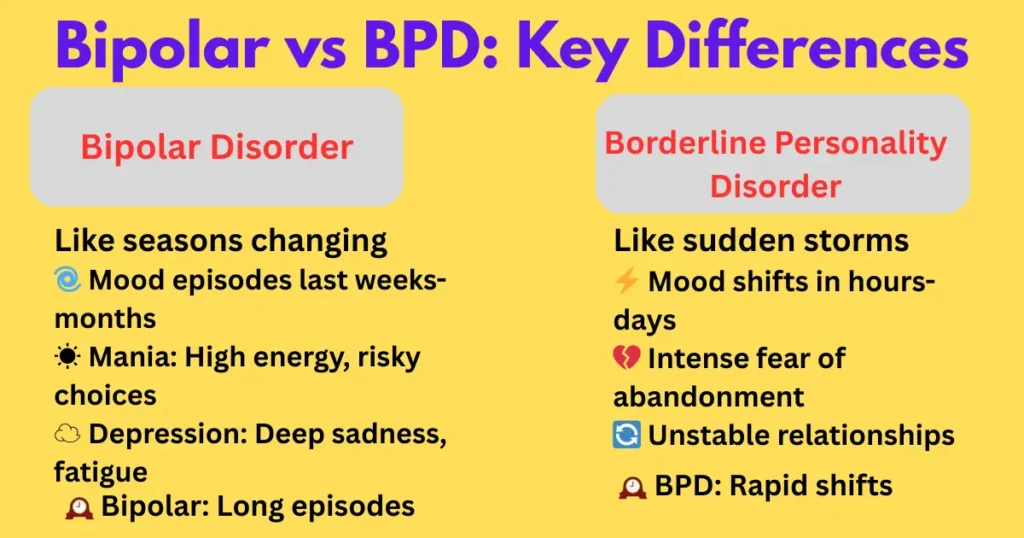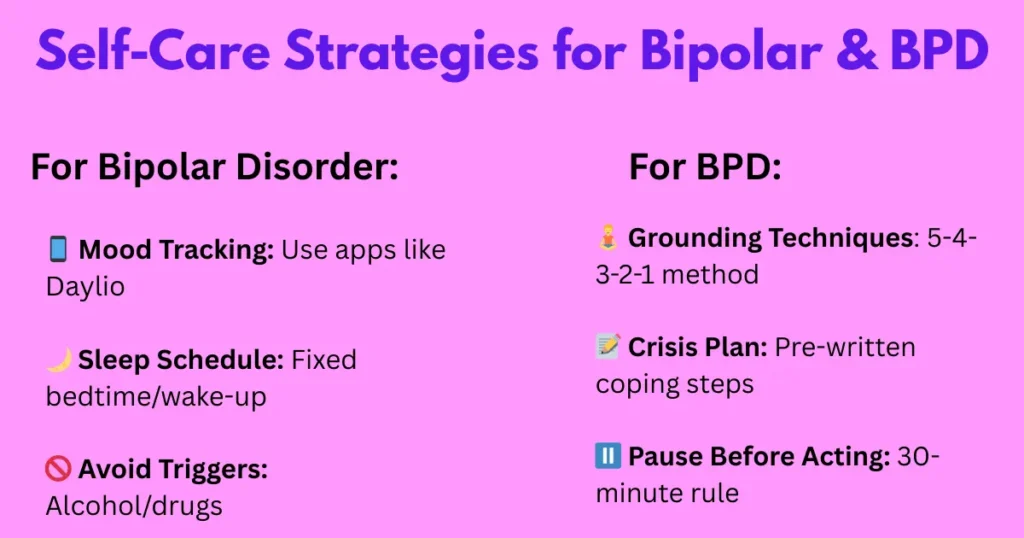Understanding the difference between Bipolar and Borderline Personality Disorder is crucial when mood swings take control of your life. It can be challenging to determine whether you are dealing with bipolar disorder or borderline personality disorder (BPD). Confusing the two can lead to years of incorrect treatments.
While one disorder has mood changes that resemble the changing seasons, the other experiences rapid shifts like sudden storms. Recognizing this difference between bipolar and borderline personality disorder is key to finding the right treatment and improving your overall quality of life.
In this article, we will look at the unique traits of both disorders, helping you identify them and offering insights into effective treatment options.

Understanding Bipolar and Borderline Personality Disorder
What is Bipolar Disorder?
Bipolar disorder is a mood disorder characterized by extreme mood swings that include manic or hypomanic episodes (elevated mood) and depressive episodes (low mood). These mood swings can last for days, weeks, or even months and are usually not triggered by external events.
Symptoms of Bipolar Disorder:
Manic Episodes:
- High energy and reduced need for sleep
- Racing thoughts and rapid speech
- Impulsive behavior (e.g., excessive spending, risky decisions)
Depressive Episodes:
- Extreme sadness or hopelessness
- Fatigue and lack of interest in activities
- Thoughts of death or suicide
Types of Bipolar Disorder:
Bipolar I: Severe manic episodes lasting at least a week
Bipolar II: Milder manic episodes (hypomania) and major depression
Cyclothymic Disorder: Less extreme mood fluctuations over a long period (two years)
What is Borderline Personality Disorder (BPD)?
Borderline Personality Disorder is a personality disorder characterized by persistent emotional instability, difficulty in managing relationships, and impulsive behaviors. People with BPD experience rapidly changing emotions and have an intense fear of abandonment.
Symptoms of BPD:
- Emotional Instability: Extreme mood swings that occur within hours or days.
- Fear of Abandonment: Intense anxiety or panic at the thought of being abandoned.
- Unstable Relationships: Switching between idealizing and devaluing others.
- Impulsivity: Engaging in reckless behaviors such as self-harm, substance abuse, or risky sexual behavior.
- Chronic Feelings of Emptiness: A constant sense of emotional void.
read more: Borderline Personality Disorder in Men’s Mental Health

Key Difference Between Bipolar and Borderline Personality Disorder
Understanding the key differences between bipolar and borderline personality disorder can help in diagnosis and treatment:
| Feature | Bipolar Disorder | Borderline Personality Disorder (BPD) |
| Mood Duration | Last days to months (manic or depressive episodes) | Lasts hours to days (rapid emotional shifts) |
| Primary Cause | Biological (brain chemistry, genetics) | Environmental (often related to trauma, upbringing) |
| Self-Harm | Occurs during depressive episodes only | Frequent self-harm to manage emotional pain |
| Relationships | Stable between mood episodes | Intense and unstable, often characterized by fear of abandonment |
| Psychosis | Possible during mania or depression | Rare, typically only under extreme stress |
| Treatment | Medication (mood stabilizers, antipsychotics) and therapy (CBT, family therapy) | Primarily therapy (especially Dialectical Behavior Therapy – DBT) |
Overlapping Symptoms: How Can You Tell the Difference?
Both bipolar disorder and BPD involve mood instability, but the difference between bipolar and borderline personality disorder lies in the duration and triggers of these mood swings:
- Bipolar Disorder: The mood swings are episodic and last for extended periods (days, weeks, or months), often without external triggers. A manic episode can last up to a week, while depressive episodes can persist for several weeks.
- BPD: The mood swings are rapid and can change within hours or minutes. These mood shifts are typically triggered by interpersonal issues (e.g., relationship problems, fear of abandonment) rather than biological factors.
4. Can You Have Both? Dual Diagnosis
It is possible to have both bipolar disorder and borderline personality disorder. This is known as a dual diagnosis. Around 15-20% of people with BPD may also have bipolar disorder, and 30% of those with bipolar disorder may display some characteristics of BPD.
Why Dual Diagnosis Happens:
- Shared Genetic Factors: Both disorders may have genetic components.
- Childhood Trauma: Trauma is a significant risk factor for developing BPD and can exacerbate bipolar disorder.
- Misdiagnosis: Due to overlapping symptoms, a person with both disorders may be misdiagnosed.
Challenges of Dual Diagnosis:
- Treatment Complexity: Requires a combination of mood stabilizers (for bipolar disorder) and therapy (like DBT for BPD).
- Higher Suicide Risk: Individuals with dual diagnoses face a higher risk of suicide.
- Frequent Hospitalizations: Due to the complex nature of both disorders, patients with dual diagnoses may require more frequent hospitalizations.
Treatment Options: How to Manage Both Conditions
For Bipolar Disorder:
- Medications: Lithium, Lamotrigine, and Quetiapine are commonly prescribed. For a deeper understanding of these medications and their role in managing bipolar disorder, visit the NIMH Bipolar Disorder Overview.
- Therapy: Cognitive-behavioral therapy (CBT) and family therapy can help manage episodes and support the individual’s well-being.
For Borderline Personality Disorder (BPD):
- Dialectical Behavior Therapy (DBT): The gold standard therapy for BPD, focusing on emotional regulation, distress tolerance, and interpersonal effectiveness.
- Medications: SSRIs (Selective Serotonin Reuptake Inhibitors) can help manage depression or anxiety symptoms, but therapy is the primary treatment.
For Dual Diagnosis:
- Mood Stabilizers: Medications such as Lithium, combined with antipsychotics, to stabilize mood.
- DBT: Dialectical Behavior Therapy is essential for emotional regulation and improving interpersonal relationships.
- Trauma-Focused Therapy: If trauma is a factor, therapies like EMDR (Eye Movement Desensitization and Reprocessing) or Schema Therapy can help.

Self-Help Strategies for Bipolar and BPD
For Bipolar Disorder:
- Track Your Mood: Use a mood tracking app like Daylio to monitor mood changes.
- Maintain a Sleep Routine: A regular sleep schedule can help prevent mood episodes.
- Avoid Drugs/Alcohol: Substance use can trigger or worsen mood swings.
For BPD:
- Practice Grounding Techniques: Try techniques like 5-4-3-2-1 to manage panic or emotional distress.
- Create a Crisis Plan: Develop a list of coping strategies for when emotions become overwhelming.
- Delay Impulsive Actions: Practice waiting before acting on self-destructive or impulsive thoughts.

Final Thoughts
Understanding the difference between bipolar and borderline personality disorder is crucial for those experiencing emotional challenges. By recognizing these differences, individuals can pursue the right treatment options and ultimately improve their quality of life.
If you or someone you care about is struggling with mood swings or emotional instability, taking the first step to seek professional help can make all the difference. Remember, understanding your mental health is the key to unlocking a brighter, healthier future.

